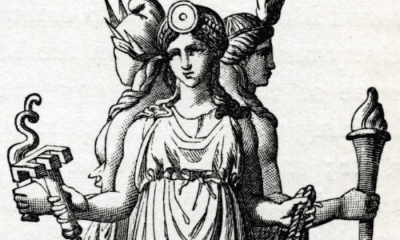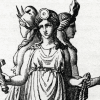Greek
Is Hercules in the Bible?
In what ways did a Greco-Roman demi-god make his way into the Christian Bible?
Hercules was a filk hero and demi-god of the Greek, and later Roman, pantheon. As such he was never worshiped by the ancient people of Judea and did not feature in their traditional stories.
He is named once, however, in an account that is included in some versions of the modern Bible. During a period of Greek dominance over Jerusalem and Judea, a festival to Hercules is mentioned in the actions of a Jewish high priest who betrayed his culture.
As a character, however, Hercules is not directly named. He may be indirectly featured in the Old Testament, however, in the character of Samson.
The legendarily strong judge of ancient Jewish tradition has parallels to Hercules in more than just might. Their shared origins makes Samson a Hercules-like figure in Judeo-Christian religion.
Hercules in the Old Testament
The modern Bible is composed of two parts, the Old Testament and the New, which record different eras in the development of Judaism and Christianity.
The Old Testament is based on the Jewish Tanakh, recording the history of the Jewish people from the creation of the world through the Babylonian exile of the 6th century BC. In some versions of the Bible, the Old Testament is expanded to include works from Hellenistic Judean culture as well.
As a character, Hercules was not a part of the Old Testament. Both the Jewish faith and the Christian are monotheistic, meaning they did not adopt the gods of the other cultures they interacted with.
Hercules, therefore, does not exist as a character in his own right in the Bible.
Many people, however, have seen parallels between the Greco-Roman Hercules and the character of Samson in the Old Testament.
Samson, sometimes spelled Sampson, is the last of the ancient judges recorded in the book of that name. He was granted almost superhuman strength to defend his people against the Philistines.
Part of the vow Samson took to receive this gift was that he was never to shave or cut his hair. He married a Philistine woman, Delilah, however, who cut his hair as he slept to deprive him of his power.
The similarities between Samson and Hercules go beyond their extraordinary strength.
The first of Samson’s legendary feats was killing a lion with his bare hands. The scene is similar to that of the first labor of Hercules, killing the Nemean Lion.
Samson, however, is not exactly the same as Hercules by any means. There are notable similarities in their stories, but they are only loosely related.
Worship of Hercules is directly mentioned in 2 Maccabees, although not among the Jewish people themselves. Whether this is considered canonical, however, is open to debate.
2 Maccabees is a deuterocanonical book involving the history of Jerusalem in the 2nd century BC. This means that the Catholic and Orthodox churches include it as a canonical book of the Bible, while Protestant faiths consider it apocryphal and it is not included in Hebrew texts.
The story concerns Jason, a high priest who gained his position by promising tributes to the Seleucid Greek king that controlled the region at the time. The people of Jerusalem were angered that Jason had undermined their traditional culture by supporting Hellenization, rebelled against his leadership.
In an attempt to regain the king’s favor, Jason sent silver to Tyre to be used in the festival of Hercules. The financial support of a pagan god further distanced him from Jewish tradition.
Ultimately, Jason’s plan to reestablish Seleucid Greek culture in Jerusalem failed. Jason died in exile and, while Jerusalem would be controlled by other foreign powers, Jewish culture was maintained.
My Modern Interpretation
While the historical accuracy and religious significance of 2 Maccabees is debatable, it does provide insight into the relationship between the Greeks and their neighbors.
While we tend to think of Greece in terms of its modern geographic location, in the ancient world it was a major colonial and trade power. Greek culture and influence expanded far beyond the country’s modern borders.
The Seleucid Empire grew out of that of the Macedonians, who under Alexander the Great had expanded far into Asia. As shown in 2 Maccabees, this Hellenistic empire ruled over many cultures that did not share their beliefs.
The story of Jason is set during the decline of the Seleucids. The Maccabean War furthered weakened the already struggling Empire.
2 Maccabees is thought to have been written by someone who was well educated in Greek literature and culture. Its writing style and the details given about life under Seleucid power indicate that the author was educated in the Greek tradition.
While the details of the story can be open to interpretation, it can be assumed that the author was truthful in his depictions of Hellenistic culture at the time. In addition to the influence of Greek culture on Judea, we can also see that the Tyrean festival of Hercules was a major event that, according to the donation made by Jason, required extensive funding and planning.
While the mention of Hercules in 2nd Maccabees shows a historical link between Greek religion and the Near East, Samson’s tale shows a much older relationship.
Both Hercules and Samson are examples of a familiar archetype in Near Eastern mythology. The supernaturally-strong folk hero is a common theme in ancient folklore that originated in the region.
While Hercules is remembered as a figure in Greco-Roman mythology, it is generally accepted that his legends were first developed in the Near East. He and Samson both belong to the strong heroic archetype seen in other characters like the Sumerian Enkidu.
In addition to having exceptional strength and killing lions without the use of weapons, there are many details in the stories of Hercules and Samson that parallel one another.
For example, both drank water from a rock when they were suffering from extreme thirst. Both tore down the gates of a city at some point in their legends, and both had births that were divinely-caused.
Both men also met deaths that were indirectly brought about by the actions of their wives. Hercules and Samson were both weakened by their lovers’ betrayals, but ultimately died at their own hands.
Some scholars believe that the stories of Hercules, and by extension the archetype he belonged to, may have been inspired by a real figure. This prehistoric man would have been a strong hunter who performed feats that earned him great renown among his own people.
As these stories were passed down, they became more fantastical. The man who inspired the archetype may have once killed a lion, but in Greek culture it was said to be impervious to weapons and in Jewish tradition its body was filled with honeybees.
Judeo-Christian tradition holds Samson to be a real figure from history who performed incredible feats. If the historical interpretation of the origins of the Near Eastern folk hero archetype are correct, this may not be far from the truth.
Both Hercules and Samson grew out of the same archetype, which possibly originated with the stories of an exceptionally strong and successful leader. While Hercules himself did not feature in the Bible, he is indirectly present through Samson.
In Summary
As a figure in Greek and Roman mythology, the character of Hercules is not featured in the Christian Bible or Jewish Tanakh. Certain Old Testament texts, however, make reference to the ways in which Greek and Jewish cultures may have interacted in the ancient past.
Hercules is mentioned as a foreign god in 2 Maccabees, a book that appears in only some versions of the modern Bible. In a period of intense Hellenization under the rule of the Seleucid Empire, the offering of silver to the temple of Hercules was just one way in which the high priest Jason betrayed his own culture.
While this is the only direct mention of Hercules in the Bible, there is also an indirect inclusion of the character in a much older story.
The Jewish judge Samson has many obvious parallels to the Greek hero. Both were made exceptionally strong through divine influence over their births, both killed lions with their bare hands as one of their first feats, and both took their own lives after being weakened by the actions of a woman.
Samson and Hercules both belong to a heroic archetype that grew out of the prehistoric Near East. Some historians believe that these legends grew out of the exploits of a real person who lived in the prehistoric past.
Samson and Hercules are not identical as their stories diverged long before either was written down. Despite the different cultural influences and religious significance of the characters, however, there are enough similarities to say that Samson and Hercules share a common source.



